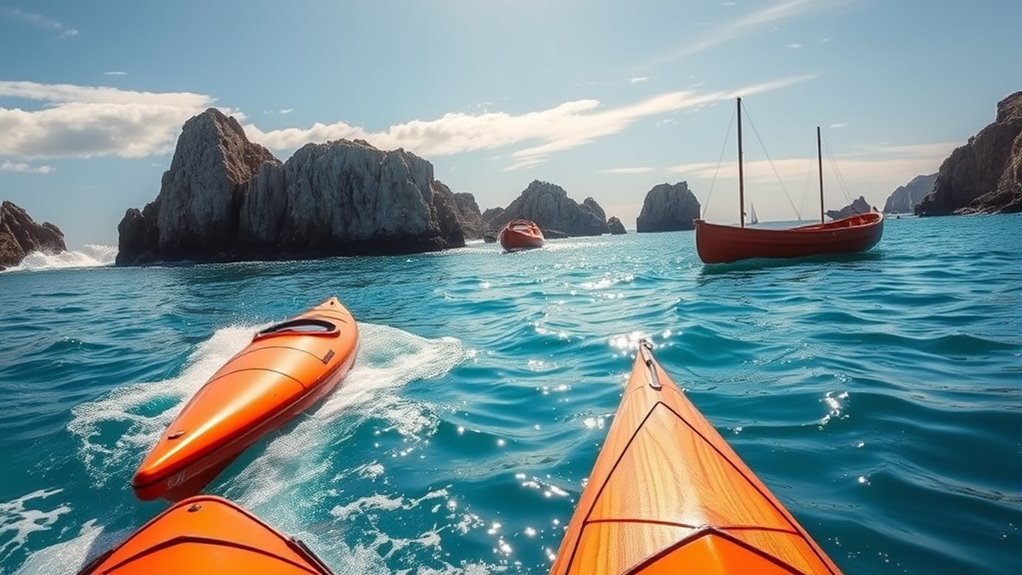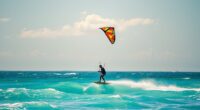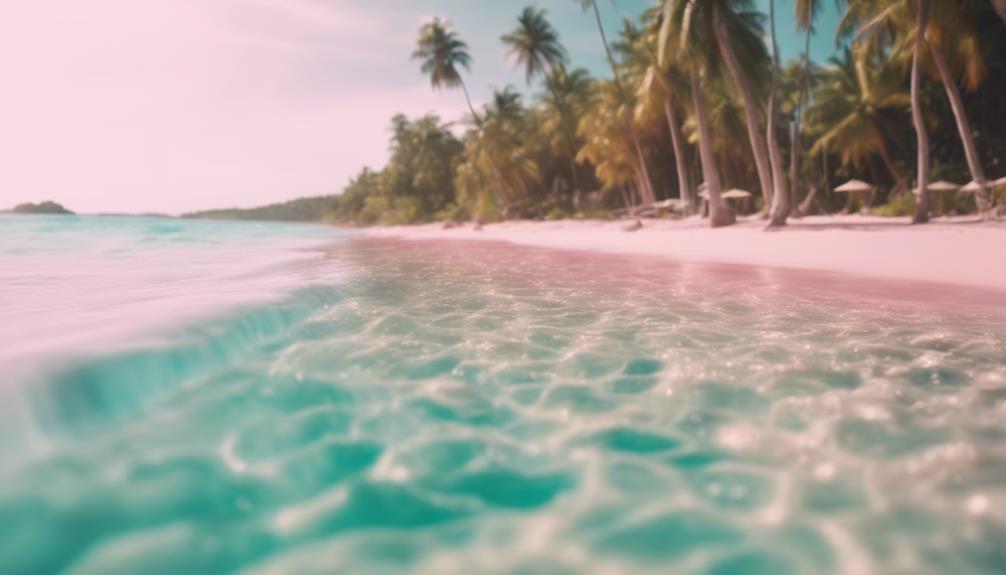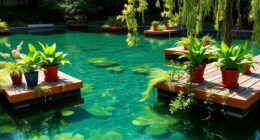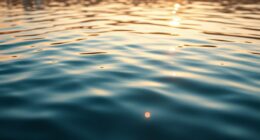Choosing between a kayak and a canoe for coastal touring depends on your priorities. Kayaks offer better maneuverability, quick responses, and handle rough waters well, making them ideal for unpredictable coastlines. Canoes provide more stability, ample gear space, and are comfortable for long trips, perfect for relaxed exploration. Understanding their differences helps you match the vessel to your adventure style. Keep exploring to learn more about which option suits your coastal journeys best.
Key Takeaways
- Kayaks offer better maneuverability and quick response in rough waters, ideal for unpredictable coastlines.
- Canoes provide more stability and ample space for gear, suitable for long-distance coastal trips.
- Kayaks are lower profile and handle waves and currents efficiently, enhancing safety in challenging conditions.
- Canoes are open and more comfortable for extended paddling, but less agile in turbulent waters.
- Material and hull design influence durability and performance, affecting suitability for different coastal environments.
Comparing Design and Structure
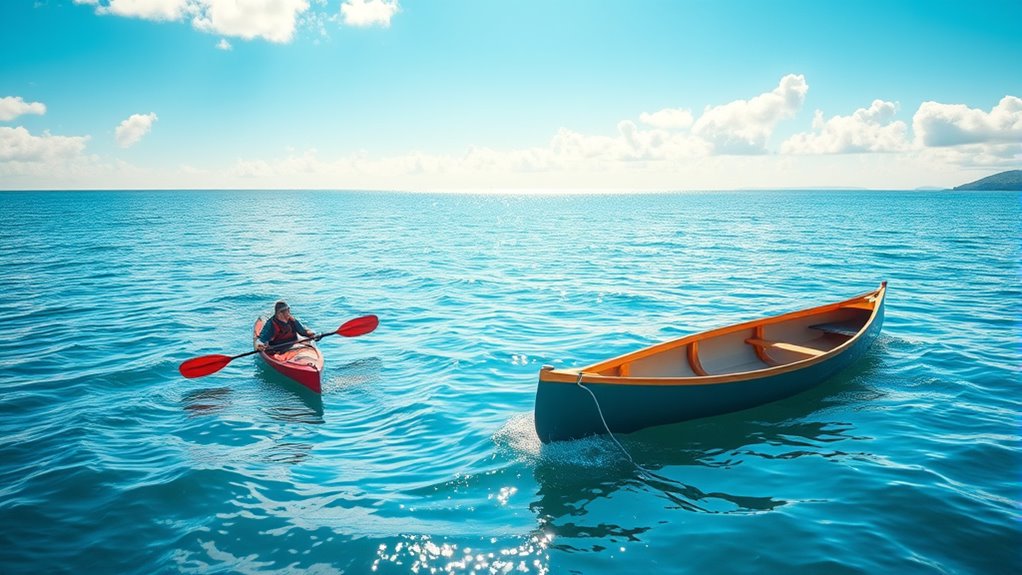
When comparing the design and structure of kayaks and canoes, it’s clear that each vessel is built for different purposes. Kayaks are typically enclosed or semi-enclosed, with a low profile that keeps you close to the water. They feature a narrower, streamlined hull designed for agility and speed. You sit low inside, often with your legs extended forward, and use a double-bladed paddle for efficient strokes. Canoes, on the other hand, are open-topped with wider, more stable hulls. They offer more room for gear and passengers, and you usually sit on a bench or kneel. The single-bladed paddle used in canoes provides a different paddling experience focused on stability and control. Both designs serve specific needs, shaping how you maneuver and enjoy coastal waters. Additionally, design and structure play a crucial role in determining the suitability of each vessel for various coastal environments and activities, including considerations of stability and maneuverability. The differences in hull shape and construction also influence how each vessel handles waves and currents, affecting overall safety and performance. For example, the material composition of each vessel impacts their durability and weight, which are important factors for coastal touring. Incorporating features like buoyancy chambers can further enhance safety by improving buoyancy and stability in challenging conditions.
Evaluating Performance and Suitability

The performance and suitability of kayaks and canoes for coastal touring depend on how well each vessel matches your specific needs and the conditions you’ll encounter. Kayaks offer better maneuverability and stability in rough waters, making them ideal for unpredictable coastlines. They typically handle waves and wind efficiently, enabling quicker responses to changing conditions. Canoes, on the other hand, excel in stability and carrying capacity, which benefits long-distance trips or carrying extra gear. If you prioritize speed and ease of handling in challenging conditions, a kayak may be more suitable. For relaxed touring with heavy loads, a canoe provides comfort and support. Consider your experience level, trip duration, and expected water conditions to determine which vessel aligns best with your coastal adventures.
Frequently Asked Questions
Which Vessel Is Better for Beginner Coastal Explorers?
If you’re a beginner exploring the coast, a kayak might be your best choice. It’s easier to maneuver, provides better stability, and requires less strength to paddle. You’ll feel more confident steering nearshore waters and handling waves. Canoes, while spacious, can be more challenging to control, especially for newcomers. So, for safety and ease, starting with a kayak helps you build skills and enjoy your coastal adventures more comfortably.
How Do Weather Conditions Affect Kayak and Canoe Use?
Weather conditions considerably impact your kayaking or canoeing experience. Strong winds can make paddling harder and cause instability, especially in open waters. Rain and storms reduce visibility and increase risk, so you should reconsider heading out during bad weather. Cold temperatures can lead to hypothermia if you’re not properly dressed. Always check the forecast, dress appropriately, and be prepared to adjust your plans to stay safe on the water.
What Safety Gear Is Recommended for Coastal Touring?
When coastal touring, you should always wear a life jacket, preferably one suitable for water sports. A whistle or signaling device helps you alert others in emergencies. Carry a waterproof communication device like a marine radio or cell phone in a dry bag. Additionally, wear appropriate clothing for weather, use sun protection, and bring safety equipment like a bilge pump, first aid kit, and navigation tools to stay safe on the water.
Can Kayaks and Canoes Handle Rough Sea Conditions?
Did you know that most kayaks are designed to handle waves up to 3 feet high? When it comes to rough sea conditions, kayaks generally perform better because they’re more stable and easier to maneuver in choppy waters. Canoes, however, tend to be less suitable as they’re more prone to capsizing in strong currents or high waves, making kayaks the safer choice for challenging coastal environments.
Which Vessel Offers More Storage for Long Trips?
When considering long trips, you want a vessel with ample storage. Canoes typically offer more space due to their open design, allowing you to stow gear easily inside. Kayaks, especially touring models, often have dry storage compartments and hatches, but overall, they tend to provide less capacity than canoes. If storage is your priority, a canoe might be the better choice for extended adventures.
Conclusion
Ultimately, whether you choose a kayak or a canoe for coastal touring, your experience depends on your preferences and adventures ahead. Coincidentally, it’s often the small details—like your comfort with stability or your need for speed—that tip the scales. Whichever vessel you pick, it’s the journey itself that truly matters. So, trust your instincts, embrace the water, and let each paddle stroke bring you closer to your next unforgettable coastal discovery.

